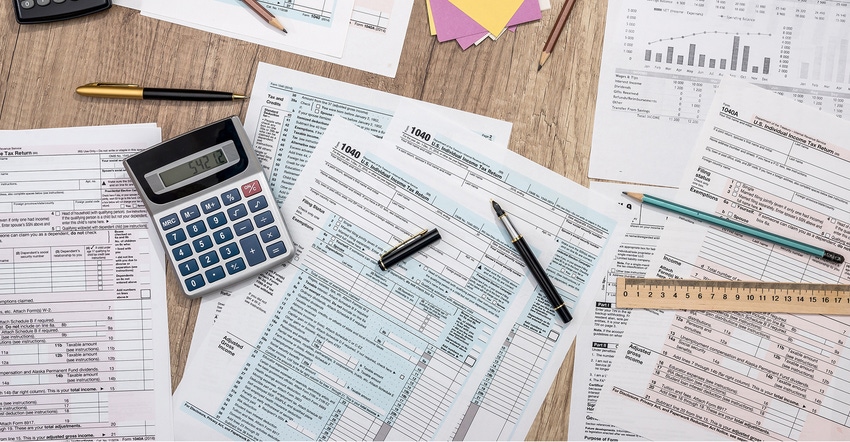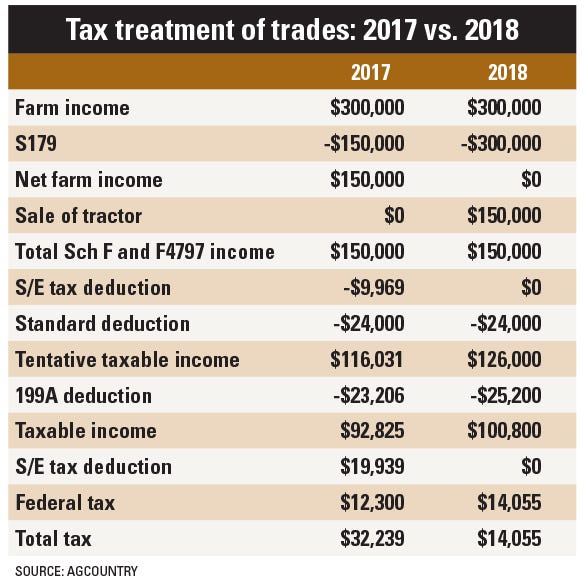October 9, 2018

By Jason Grunewald
Two of the big changes that came from the Tax Cuts and Jobs Act passed in late 2017 include the new Section 199A deduction and the tax treatment of trades (like kind exchanges) for personal property, such as farm equipment and livestock.
The Section 199A deduction provides for a 20% deduction of qualified business income, which replaces the old Section 199 Domestic Production Activities Deduction rules. Some of the basics of the calculation are:
• Eligible entities are sole proprietors, S-corporations and partnerships
• Reduces taxable income after adjusted gross income is calculated
• Will not reduce self-employment tax owed
• Will likely not reduce state tax owed
If taxable income is below $157,000 for single or $315,000 for married filing jointly (MFJ) taxpayers and no co-op sales are present, the calculation is fairly straightforward as follows:
The 199A deduction is the lesser of 20% of combined QBI or 20% of net taxable income minus capital gains.
If co-op sales are present, the calculation adds another layer of complexity. The 199A deduction is the lesser of 20% of combined QBI minus the lesser of 9% of net income attributable to co-op sales; or 50% of wages paid to earn income from the cooperative; or 20% of net taxable income minus capital gains.
As taxable income goes above the limits of $157,000 ($315,000 MFJ), the calculation becomes even more complicated and will need to be discussed with your tax preparer.
How can you prepare and understand how the calculation will affect your tax return?
• Percentage of co-op sales will affect the amount of deduction allowed.
• Co-ops are still able to pass through 199A deductions.
• Amount of wages paid by the qualified business can affect the deduction.
• Items that reduce taxable income like self-employed health insurance deduction, retirement deductions, HSA and standard deductions will reduce AGI and taxable income.
• Health insurance premium tax credits will need greater attention due to certain AGI limits because AGI may be higher for taxpayers in 2018. The 199A deduction is calculated after AGI compared to the old DPAD reducing AGI.
Trade or like-kind exchanges
Previously, trading an asset did not trigger taxable income. Depreciation on the traded asset simply continued with the boot eligible for current depreciation. New tax law requires reporting the trade as a sale based on the trade allowance received. In turn, the entire cost of the new asset becomes eligible for depreciation.
Working through an example to obtain net income from Schedule F and Form 4797 illustrates the differences.
You’re purchasing a tractor with a list price of $300,000, and you receive a trade allowance of $150,000.
• Under 2017 law the new purchase had a basis of $150,000 ($300,000 list price minus $150,000 trade allowance). Amount available for section 179 is $150,000 and no sale of equipment reported. Depreciation deduction will reduce self-employment income on Schedule F.
• Under 2018 law the new purchase beginning basis is $300,000, which is the list price. Amount available for Section 179 is $300,000. A sale of $150,000 is recorded on form 4797 of the tax return and the sale is not subject to self-employment taxes.

You may look at this table showing this example and think the new law is a better way to report the trade since you’re not paying self-employment tax, but additional considerations are needed when comparing these changes.
States like Minnesota, Wisconsin and Iowa do not conform to federal Section 179 and bonus depreciation rules. Therefore, a taxpayer may not be able to deduct the total cost of the new asset in one year and there will be additional taxes owed due to depreciation addback in the first year.
If there is a loan on either tractor, you could be setting yourself up for trouble by not having depreciation deductions to offset principal payments in the future.
Opportunities to use Schedule J for farm income averaging are reduced.
If self-employment income is not shown year after year, Social Security benefits could be reduced when you retire.
You may be unable to utilize your self-employed health insurance deduction. In some cases, taxpayers may also miss out on qualifying for the Earned Income Credit.
These are just a few of the changes occurring on your tax return for 2018. Tax planning and application of the new tax law will be of the utmost importance.
Grunewald is a CPA and senior tax specialist with AgCountry Farm Credit Services, Fargo, N.D.
You May Also Like




